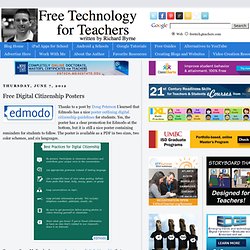

The Teacher's Guide To Digital Citizenship. How you act online is important. Not just because everything is stored, backed up, and freely available to anyone with a keyboard. But because your online reputation is actually just your reputation. There’s really no difference between online and offline anymore. In an effort to keep everyone behaving, Microsoft has just unveiled a new (free) curriculum that’s all about digital citizenship , intellectual property rights , and creative content . It offers cross-curricular classroom activities that align with the AASL and ISTE national academic standards. How It Works Four units comprise the curriculum resources. Each unit has 4-6 of these project-oriented activities, one of which serves as the culminating lesson for the unit. The following is simply a description of each unit followed by the learning objectives for that particular unit.
Unit One: Creative What? This unit explores the general topics of intellectual property, creative content , and creative rights. Discuss Safety and Security Issues of Online Video Sharing - Teacher Professional Development. 26 Internet safety talking points. A Simple Guide to All That Teachers Need to Know about Digital Citizenship. Digital citizenship is a key component of the technology and media literacy.

We should not only teach our students how to be good citizens in the real physical world but how they can be good netizens of the online world as well.Today's learning requires alot of use of technology and most imprtant of all, our students are using technology on a daily basis- text messaging, blogging, Facebooking, Twittering, watching videos, gaming and networking. They live in two different but interconnected worlds. What they do online can have a severe repercussions on their real life if not properly instructed on digital safety issues and this is where digital citizenship fits in. Digital citizenship can be defined as " the norms of appropriate, responsible behaviour with regard to technology use. "It is the combinatio of technical and social skills that enable a person to be successful and safe in the information age.
The role of teachers 2- Google+ Safety Guide for Educators Webliography : 10 Interactive Lessons By Google On Digital Citizenship. 10 Interactive Lessons By Google On Digital Citizenship Added by Jeff Dunn on 2012-07-22 YouTube has a firm place in the current classroom. From Khan Academy’s videos to YouTube EDU and beyond, there’s a reason all these videos are finding a home in schools. In an effort to help keep the ball rolling, Google just launched a set of 10 interactive lessons designed to support teachers in educating students on digital citizenship.
A topic obviously quite close to Google’s heart. Google (which owns YouTube) built the lessons to educate students about YouTube’s policies, how to flag content, how to be a safer online citizen, and protect their identities. Below is a list of lessons, and the recommended flow for delivery. Or you can download the Full Teacher’s Guide or the Full Set of Slides in PDF . The killer feature for this curriculum is the extra features that come with each video. Category: Videos Tags: digital citizenship , guide , How To , presentations , Videos You may also like 4 Comments. 7 Outstanding Web Resources for Teachers and Students to Learn about Copyright Issues. As more and more of our students are having free access to internet and its plethora of resources, copyright issues jump to the surface and it becomes incumbent on us as educators and teachers to help these students learn about how to respect copyrights and avoid infringment issues.

Students need to understand that not everything online can be used freely. There are laws and regulations they must abide by to become good netizens. In this regard, Educational Technology and Mobile Learning has compiled a list of some great tools that you can use to teach your students about copyright issues. Check them out : Introducing School-Wide Digital Citizenship Practices with iPads. An elementary school in our district recently got 30 iPads and asked for some advice implementing them with students and teachers.

In addition to suggesting some starter apps, I recommended that we have conversations with kids around the appropriate use of these devices. While almost every child has used an iPad, iPod Touch, or iPhone, the exciting learning opportunities these mobile, Internet-connected, media creation devices create also open the door to new challenges. Cyberbullying or inappropriate web publishing happens more through the camera than regular computer use does; the mobility of the device combined with the reality that multiple users are using the device with no personalized, password-protected, network-tracked accounts makes it more challenging to keep track of who is doing what with the device or that the device itself is safe.
Rather than tell the students how they should and should not use iPads, I felt compelled to involve the students in the conversation. Free Digital Citizenship Posters. Thanks to a post by Doug Peterson I learned that Edmodo has a nice poster outlining digital citizenship guidelines for students.

Yes, the poster has a clear promotion for Edmodo at the bottom, but it is still a nice poster containing reminders for students to follow. The poster is available as a PDF in two sizes, two color schemes, and six languages. Digital Citizenship & iCitizenship - Gone Virtual. Digital Citizenship Poster for Middle and High School Classrooms. Digital Citizenship & iCitizenship - Gone Virtual. Digital Citizenship Poster for Elementary Classrooms.